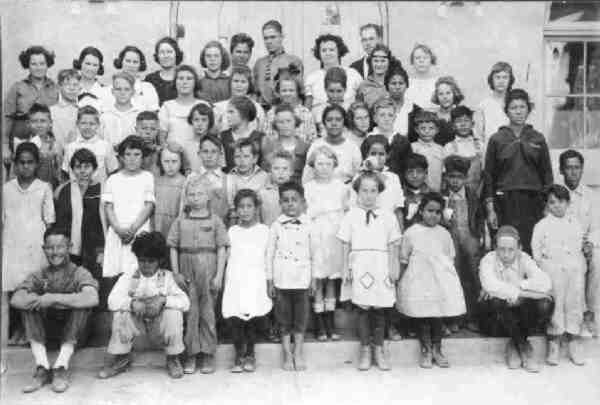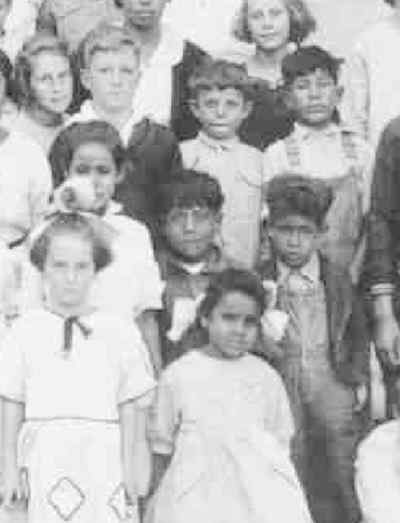
Figure 1.--The children at thus school wear mostly workclothes. They do not appear to have dressed up for the photograpg at all.


Figure 1.--The children at thus school wear mostly workclothes. They do not appear to have dressed up for the photograpg at all. |
HBC knows little about this scool scene. Often individual classes were photographed, but this seem to be the whole school. This school group looks to have been photographed about 1915, but it might have been a few years later. It is an unidentified image, but I would say was probably taken in a small town in a rural area. It looks like some of the children are Indian. Perhaps the school might be be in North Dakota. The children do not seemed to have dressed up for the photograph. They wear a variety of clothes, but overalls seem especially prominent. I'm not sure wether the boys wearing overalls were from poorer families or whether they were just the accepted fashion. HBC has no information on what the children thought about the different garments seen here. Did the boys in ovralls want to wear better clothes or did the other boys envy the informal overalls.
HBC is able t roughly date this image, but the precise year is more difficult. This school group looks to have been photographed about 1915. That is just a rough estimate. It may have been taken a little later, perhaps 1920, but I do not believe it was taken much earlier than 1915 as I think that at least some the younger child would have worn fancier clothes in an earlier photograph.
It is an unidentified image, but I would say was probably taken in a small town in a rural area. The photograph appears to have been taken in front of a substantial building, so it wasn't a small rural school out in the country. It looks like some of the children are Indian. Perhaps the school might be be in North Dakota. The lack of segregation suggests the northern plains rather than a more southern location like Oklahoma.
The children in this photograph do not seem to have dressed up for the photograph. I'm not sure why this would have been. Presumably a school photograph would have been a major occasion.
This looks to be an elementary school which would mean children through te 6th grade. The 6th grade would beean children to about 12 or 13 yeras old. As it is a rural school some of the boys may have taken a little longer to finish school. Some rural schools may have also offered classes for 7th and 8th graders. Interestingly there seems to be quite a wide age range. This may be the entire school and not a single class.
This looks to be a photograph taken during the early summer. They children would have dressed much more warmly during the winter.
The boys appears to wear mostly work clothes like overalls and coveralls, although the outfits of the boys in the back rows are difficult to see. There is little evidence that any of the boys put on anything special for this photograph. This looks to be what the children wore every day for school.
The children for the most part are not wearing any type of headwear. It is likely that in 1915 than manuy if not most of the children would have cope to school with hats and caps. Presumably they put them away for the photograph .One boy in the front row wears a beannie. He seems rather old to be wearing a beanie, but I'm not sure just what age boys wore them. None of the other children, however, are shown with their hats or caps.
One boy wears a juvenile styled jacket which buttons to the collar. Another boy wears a jacket or sweater with overall. Another boy werars to wears a black or navy blue jacket with an open knecked white shirt.
Only one boy wears a shirt with a tie. One younger boy wears a modest bow with a button up jacket. All the other boys wear open necked shirts.
Quite a few boys wear overalls. Overall about half of the boys wear overalls. This shows the substabntial differences between dress at rural and urban schools. This difference continued through the 1930s, but began to change after World War II in the 1940s.
One of the younger boys wars a coverall-type outfit. Interestingly it has a Russian blouse open collar. Some American boys wore Russian blouses, but they were more popular in urban areas and in Europe. HBC wants to have a look at a Sears or Montgomery Ward catalog to see if this was one of the styles offered. This might also help date the image.
All the girls at the school wear dresses. None have come to school in overalls or work clothes. The girls appear to take dressing up a little more seriously than the boys. Girls might wear overalls while working on th farm, but they clearly didn't come to school in them. The modern fashion of girls' wearing boys clothes had clearly not developed yet.
One younger boy in the front wears kneepants without socks or shoes. He appears to be the only one coming to school barefoot. He could also be wearing knickers, but they rather look like kneepabnts to me.
One boy appears to wear knickers, but the image is indistinct. It is unclear what kind of pants the boys in the back row who are not in overalls are wearing. Presumably several of the boys in the back rows are also wearing knickers.
The one boy who seems to be wearing knickers appears to be wearing long stockings. One boy in overalls wears white socks. The girls all appear to wear long stockings with their dresses, except for one little girl who wears white kneesocks.
The boys all appear to wear heavy work boots, except for one barefoot boy and the older boy at the left who wears shoes and white socks. Some of the girls appear to be wearing shoes.

Figure 5.--Notice the jacket or swearter the boy on the right is wearing over his overalls. The boy on the left may be wearing a jacket with an open knecked white shirt. |
HBC is unsure how the boys felt about the fashions shown here. Did boys wear overalls because they were comfortable. Or would many rather have worn knickers and lock stockings. Was it a question of affluence. Was it the poorer boys who wore overalls. Also would the boys have prefrred to have come to school barefoot or was it again a question of affluence.
Related Chronolgy Pages in the Boys' Historical Web Site
[Main Chronology Page]
[The 1900s]
[The 1910s]
[The 1920s]
[The 1930s]
[The 1940s]
[The 1950s]
[The 1960s]
[The 1970s]
[The 1980s]
[The 1990s]
[The 2000s]
Navigate the Relate Boys Historical Clothing Style Pages
[Main country page]
[Long pants suits]
[Short pants suits]
[Lederhosen]
[Kneesocks]
[Eton suits]
[Jacket and trousers]
[Blazer
[School sandals]
